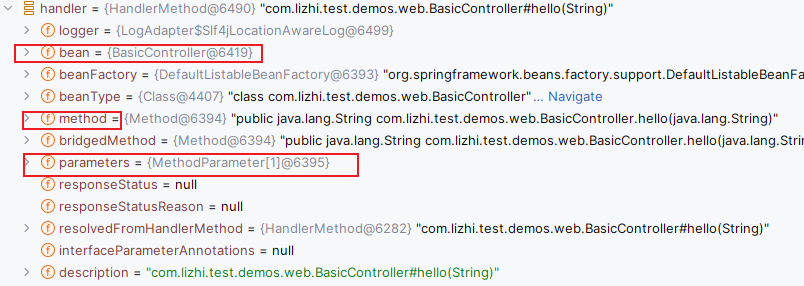今天大致来看一下Spring MVC的执行流程和初始化流程是什么样的
1,执行流程:也就是一个请求是怎么到我们Controller的
2,初始化流程:也就是那些 HandlerMapping、HandlerAdapter是怎么初始化并让我们拿到的
执行流程
我们都知道 DispatcherServlet(前端控制器) 这样的一个类,是这个类来帮我们执行的,网上的很多图以这个类为核心来画的,那是怎么来到这个类的?(大多数文章并没有说)又是怎么帮我们调用各个组件来执行这个请求的?这些都是问题,我们直接来看源码,看完源码再来画图理解。
首先创建一个最简单的项目:直接使用 Spring Initializer 来帮我们快速创建出一个Web项目,地址使用阿里的(),依赖就选择一个 starter-web 就行,就最简单的项目。
先来到我们创建的这个项目的这个类的 BasicController#hello() 方法,并在这个上面打一个断点,然后启动项目 向这个地址发送一个请求:

还记得我们上篇文章说的怎么看源码的事情吗?直接来看调用栈:
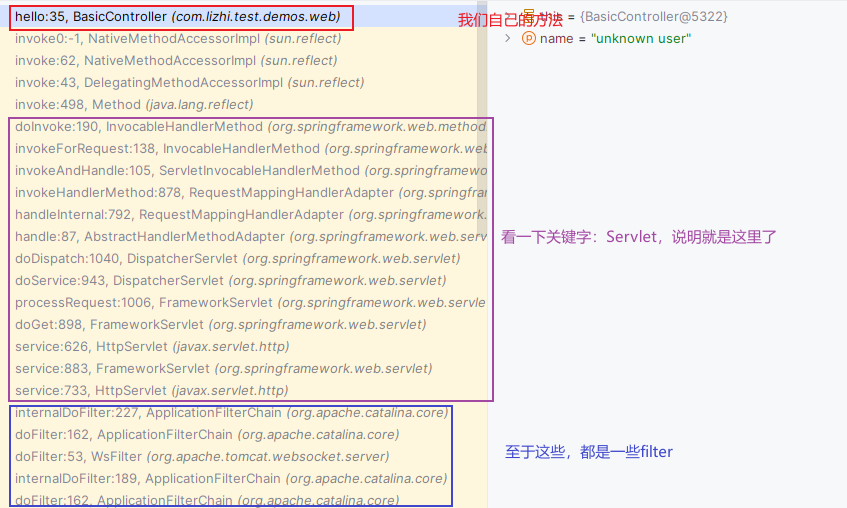
我们通过调用栈又可以发现:
红色框里是我们自己的代码
紫色框里就是执行流程相关的了,SpringMVC 的底层不就是Servlet 吗。Servlet 不就是我们 JavaWeb 学的东西吗?Servlet、Filter、Listener 三大组件。
蓝色框里是一些 filter 过滤器
我们直接在这里打一个断点,开始的地方:
HttpServlet
javax.servlet.http.HttpServlet#service(javax.servlet.ServletRequest, javax.servlet.ServletResponse)

先到 javax.servlet.http.HttpServlet#service(javax.servlet.ServletRequest, javax.servlet.ServletResponse) ,
然后 org.springframework.web.servlet.FrameworkServlet#service,
再到 javax.servlet.http.HttpServlet#service(javax.servlet.http.HttpServletRequest,
javax.servlet.http.HttpServletResponse),我们来看一下这个方法:
protected void service(HttpServletRequest req, HttpServletResponse resp)
throws ServletException, IOException {
String method = req.getMethod();
if (method.equals(METHOD_GET)) {
long lastModified = getLastModified(req);
if (lastModified == -1) {
// servlet doesn't support if-modified-since, no reason
// to go through further expensive logic
doGet(req, resp);
} else {
long ifModifiedSince;
try {
ifModifiedSince = req.getDateHeader(HEADER_IFMODSINCE);
} catch (IllegalArgumentException iae) {
// Invalid date header - proceed as if none was set
ifModifiedSince = -1;
}
if (ifModifiedSince < (lastModified / 1000 * 1000)) {
// If the servlet mod time is later, call doGet()
// Round down to the nearest second for a proper compare
// A ifModifiedSince of -1 will always be less
maybeSetLastModified(resp, lastModified);
doGet(req, resp);
} else {
resp.setStatus(HttpServletResponse.SC_NOT_MODIFIED);
}
}
} else if (method.equals(METHOD_HEAD)) {
long lastModified = getLastModified(req);
maybeSetLastModified(resp, lastModified);
doHead(req, resp);
} else if (method.equals(METHOD_POST)) {
doPost(req, resp);
} else if (method.equals(METHOD_PUT)) {
doPut(req, resp);
} else if (method.equals(METHOD_DELETE)) {
doDelete(req, resp);
} else if (method.equals(METHOD_OPTIONS)) {
doOptions(req,resp);
} else if (method.equals(METHOD_TRACE)) {
doTrace(req,resp);
} else {
//
// Note that this means NO servlet supports whatever
// method was requested, anywhere on this server.
//
String errMsg = lStrings.getString("http.method_not_implemented");
Object[] errArgs = new Object[1];
errArgs[0] = method;
errMsg = MessageFormat.format(errMsg, errArgs);
resp.sendError(HttpServletResponse.SC_NOT_IMPLEMENTED, errMsg);
}
}分析:就是根据不同的请求方式去执行。doGet、doPost、doPut、doDelete、doHead、doTrace。我们总共支持这么多种的请求方式
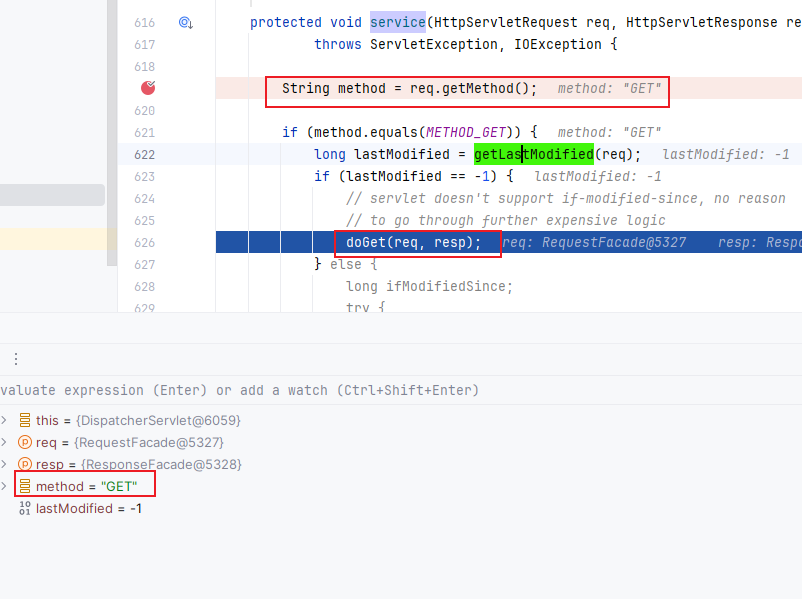
FrameworkServlet
我们这次的请求方式是 Get ,所以就来到了 org.springframework.web.servlet.FrameworkServlet#doGet 方法:
@Override
protected final void doGet(HttpServletRequest request, HttpServletResponse response)
throws ServletException, IOException {
processRequest(request, response);
}这里面又调用了 org.springframework.web.servlet.FrameworkServlet#processRequest 方法:
protected final void processRequest(HttpServletRequest request, HttpServletResponse response)
throws ServletException, IOException {
long startTime = System.currentTimeMillis();
Throwable failureCause = null;
LocaleContext previousLocaleContext = LocaleContextHolder.getLocaleContext();
LocaleContext localeContext = buildLocaleContext(request);
RequestAttributes previousAttributes = RequestContextHolder.getRequestAttributes();
ServletRequestAttributes requestAttributes = buildRequestAttributes(request, response, previousAttributes);
WebAsyncManager asyncManager = WebAsyncUtils.getAsyncManager(request);
asyncManager.registerCallableInterceptor(FrameworkServlet.class.getName(), new RequestBindingInterceptor());
initContextHolders(request, localeContext, requestAttributes);
try {
// 继续调用执行
doService(request, response);
}
catch (ServletException | IOException ex) {
failureCause = ex;
throw ex;
}
catch (Throwable ex) {
failureCause = ex;
throw new NestedServletException("Request processing failed", ex);
}
finally {
resetContextHolders(request, previousLocaleContext, previousAttributes);
if (requestAttributes != null) {
requestAttributes.requestCompleted();
}
logResult(request, response, failureCause, asyncManager);
publishRequestHandledEvent(request, response, startTime, failureCause);
}
}DispatcherServlet
这里面调用了 doService() 方法,这里的 doService() 方法是 **DispatcherServlet **类的:
protected void doService(HttpServletRequest request, HttpServletResponse response) throws Exception {
logRequest(request);
// Keep a snapshot of the request attributes in case of an include,
// to be able to restore the original attributes after the include.
Map<String, Object> attributesSnapshot = null;
if (WebUtils.isIncludeRequest(request)) {
attributesSnapshot = new HashMap<>();
Enumeration<?> attrNames = request.getAttributeNames();
while (attrNames.hasMoreElements()) {
String attrName = (String) attrNames.nextElement();
if (this.cleanupAfterInclude || attrName.startsWith(DEFAULT_STRATEGIES_PREFIX)) {
attributesSnapshot.put(attrName, request.getAttribute(attrName));
}
}
}
// Make framework objects available to handlers and view objects.
request.setAttribute(WEB_APPLICATION_CONTEXT_ATTRIBUTE, getWebApplicationContext());
request.setAttribute(LOCALE_RESOLVER_ATTRIBUTE, this.localeResolver);
request.setAttribute(THEME_RESOLVER_ATTRIBUTE, this.themeResolver);
request.setAttribute(THEME_SOURCE_ATTRIBUTE, getThemeSource());
if (this.flashMapManager != null) {
FlashMap inputFlashMap = this.flashMapManager.retrieveAndUpdate(request, response);
if (inputFlashMap != null) {
request.setAttribute(INPUT_FLASH_MAP_ATTRIBUTE, Collections.unmodifiableMap(inputFlashMap));
}
request.setAttribute(OUTPUT_FLASH_MAP_ATTRIBUTE, new FlashMap());
request.setAttribute(FLASH_MAP_MANAGER_ATTRIBUTE, this.flashMapManager);
}
try {
// 核心方法
doDispatch(request, response);
}
finally {
if (!WebAsyncUtils.getAsyncManager(request).isConcurrentHandlingStarted()) {
// Restore the original attribute snapshot, in case of an include.
if (attributesSnapshot != null) {
restoreAttributesAfterInclude(request, attributesSnapshot);
}
}
}
}经过一层层的调用后,终于来到了最核心的方法doDispatch():
// 文件上传解析器
/** MultipartResolver used by this servlet. */
@Nullable
private MultipartResolver multipartResolver;
// 处理器映射器集合
/** List of HandlerMappings used by this servlet. */
@Nullable
private List<HandlerMapping> handlerMappings;
// 处理器适配器集合
/** List of HandlerAdapters used by this servlet. */
@Nullable
private List<HandlerAdapter> handlerAdapters;
// 视图解析器集合
/** List of ViewResolvers used by this servlet. */
@Nullable
private List<ViewResolver> viewResolvers;
protected void doDispatch(HttpServletRequest request, HttpServletResponse response) throws Exception {
HttpServletRequest processedRequest = request;
// 处理器执行器链
HandlerExecutionChain mappedHandler = null;
boolean multipartRequestParsed = false;
WebAsyncManager asyncManager = WebAsyncUtils.getAsyncManager(request);
try {
ModelAndView mv = null;
Exception dispatchException = null;
try {
// 是否是文件上传的请求,如果是需要包装一下
processedRequest = checkMultipart(request);
multipartRequestParsed = (processedRequest != request);
// 通过当前请求拿到对应的 HandlerExecutionChain 对象
// 这一步是 HandlerMapping
mappedHandler = getHandler(processedRequest);
if (mappedHandler == null) {
noHandlerFound(processedRequest, response);
return;
}
// 通过 HandlerExecutionChain 对象里的 Handler 拿到 HandlerAdapter 对象
// 这一步是 HandlerAdapter
HandlerAdapter ha = getHandlerAdapter(mappedHandler.getHandler());
// Process last-modified header, if supported by the handler.
String method = request.getMethod();
boolean isGet = "GET".equals(method);
if (isGet || "HEAD".equals(method)) {
long lastModified = ha.getLastModified(request, mappedHandler.getHandler());
if (new ServletWebRequest(request, response).checkNotModified(lastModified) && isGet) {
return;
}
}
// 拦截器的前置处理
if (!mappedHandler.applyPreHandle(processedRequest, response)) {
return;
}
// 通过 HandlerAdapter 来执行我们 Controller 里的方法
mv = ha.handle(processedRequest, response, mappedHandler.getHandler());
if (asyncManager.isConcurrentHandlingStarted()) {
return;
}
applyDefaultViewName(processedRequest, mv);
// 拦截器的后置处理
mappedHandler.applyPostHandle(processedRequest, response, mv);
}
catch (Exception ex) {
dispatchException = ex;
}
catch (Throwable err) {
// As of 4.3, we're processing Errors thrown from handler methods as well,
// making them available for @ExceptionHandler methods and other scenarios.
dispatchException = new NestedServletException("Handler dispatch failed", err);
}
// 拦截器的最终处理 还会渲染 ModelAndView 对象
processDispatchResult(processedRequest, response, mappedHandler, mv, dispatchException);
}
catch (Exception ex) {
triggerAfterCompletion(processedRequest, response, mappedHandler, ex);
}
catch (Throwable err) {
triggerAfterCompletion(processedRequest, response, mappedHandler,
new NestedServletException("Handler processing failed", err));
}
finally {
if (asyncManager.isConcurrentHandlingStarted()) {
// Instead of postHandle and afterCompletion
if (mappedHandler != null) {
mappedHandler.applyAfterConcurrentHandlingStarted(processedRequest, response);
}
}
else {
// Clean up any resources used by a multipart request.
if (multipartRequestParsed) {
cleanupMultipart(processedRequest);
}
}
}
}分析:我们这里把几个核心的方法拿过来,然后一一做拆解
1,getHandler(): 在这里HandlerMapping 会根据当前请求拿到HandlerExecutionChain 对象
2,getHandlerAdapter():会拿到支持处理此Handler 的HandlerAdapter 对象
3,mappedHandler.applyPreHandle():拦截器的前置处理
4,ha.handle(): 通过HandlerAdapter 来处理
5,mappedHandler.applyPostHandle(): 拦截器的后置处理
6,processDispatchResult(): 处理结果、拦截器的最终处理
7,上面的那几个属性在启动的时候会初始化好,在初始化的时候再说
getHandler()
private List<HandlerMapping> handlerMappings;
protected HandlerExecutionChain getHandler(HttpServletRequest request) throws Exception {
if (this.handlerMappings != null) {
for (HandlerMapping mapping : this.handlerMappings) {
HandlerExecutionChain handler = mapping.getHandler(request);
if (handler != null) {
return handler;
}
}
}
return null;
}分析:就是拿到所有的HandlerMapping 调用它的 getHandler() 方法来拿到一个HandlerExecutionChain 对象
就是这个五个 HandlerMapping 对象,可自己查询这几个各自的作用
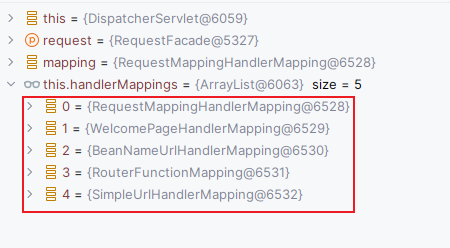
HandlerMapping
就是根据路径找到对应的 HandlerMethod(Handler)、HandlerInterceptor、然后处理跨域,并封装为HandlerExecutionChain 对象返回。
第一次拿到的是 RequestMappingHandlerMapping,来到 AbstractHandlerMapping#getHandler() 方法:AbstractHandlerMapping 是它的父类:
正好这个 **HandlerMapping **就能找到我们的 Handler。
private Object defaultHandler;
public final HandlerExecutionChain getHandler(HttpServletRequest request) throws Exception {
// 根据当前请求拿到对应的 Handler
Object handler = getHandlerInternal(request);
// 没拿到就给一个默认的 Handler
if (handler == null) {
handler = getDefaultHandler();
}
if (handler == null) {
return null;
}
// Bean name or resolved handler?
if (handler instanceof String) {
String handlerName = (String) handler;
handler = obtainApplicationContext().getBean(handlerName);
}
// 根据拿到的 Handler 和 当前请求得到一个 HandlerExecutionChain
HandlerExecutionChain executionChain = getHandlerExecutionChain(handler, request);
if (logger.isTraceEnabled()) {
logger.trace("Mapped to " + handler);
}
else if (logger.isDebugEnabled() && !request.getDispatcherType().equals(DispatcherType.ASYNC)) {
logger.debug("Mapped to " + executionChain.getHandler());
}
// 跨域处理
if (hasCorsConfigurationSource(handler) || CorsUtils.isPreFlightRequest(request)) {
CorsConfiguration config = (this.corsConfigurationSource != null ? this.corsConfigurationSource.getCorsConfiguration(request) : null);
CorsConfiguration handlerConfig = getCorsConfiguration(handler, request);
config = (config != null ? config.combine(handlerConfig) : handlerConfig);
executionChain = getCorsHandlerExecutionChain(request, executionChain, config);
}
return executionChain;
}getHandlerInternal()
来到 org.springframework.web.servlet.mvc.method.RequestMappingInfoHandlerMapping#getHandlerInternal
protected HandlerMethod getHandlerInternal(HttpServletRequest request) throws Exception {
request.removeAttribute(PRODUCIBLE_MEDIA_TYPES_ATTRIBUTE);
try {
// 调用父类的方法来处理
return super.getHandlerInternal(request);
}
finally {
ProducesRequestCondition.clearMediaTypesAttribute(request);
}
}它的父类是 AbstractHandlerMethodMapping ,所以又来到它这里来处理:
org.springframework.web.servlet.handler.AbstractHandlerMethodMapping#getHandlerInternal
private UrlPathHelper urlPathHelper = new UrlPathHelper();
protected HandlerMethod getHandlerInternal(HttpServletRequest request) throws Exception {
// 拿到请求中的请求路径
String lookupPath = getUrlPathHelper().getLookupPathForRequest(request);
request.setAttribute(LOOKUP_PATH, lookupPath);
this.mappingRegistry.acquireReadLock();
try {
// 通过请求路径拿到 HandlerMethod (核心)
HandlerMethod handlerMethod = lookupHandlerMethod(lookupPath, request);
return (handlerMethod != null ? handlerMethod.createWithResolvedBean() : null);
}
finally {
this.mappingRegistry.releaseReadLock();
}
}
lookupHandlerMethod()
我们直接来看一下是怎么拿到 HandlerMethod 的:
org.springframework.web.servlet.handler.AbstractHandlerMethodMapping#lookupHandlerMethod
protected HandlerMethod lookupHandlerMethod(String lookupPath, HttpServletRequest request) throws Exception {
// 根据路径匹配到的集合
List<Match> matches = new ArrayList<>();
// 1,根据路径找到对应的 RequestMappingInfo 集合
List<T> directPathMatches = this.mappingRegistry.getMappingsByUrl(lookupPath);
if (directPathMatches != null) {
// 2,匹配到的集合 这里面有 HandlerMethod 对象
addMatchingMappings(directPathMatches, matches, request);
}
if (matches.isEmpty()) {
// No choice but to go through all mappings...
addMatchingMappings(this.mappingRegistry.getMappings().keySet(), matches, request);
}
if (!matches.isEmpty()) {
// 3,从匹配到的集合中拿到第一个
Match bestMatch = matches.get(0);
if (matches.size() > 1) {
Comparator<Match> comparator = new MatchComparator(getMappingComparator(request));
matches.sort(comparator);
bestMatch = matches.get(0);
if (logger.isTraceEnabled()) {
logger.trace(matches.size() + " matching mappings: " + matches);
}
if (CorsUtils.isPreFlightRequest(request)) {
return PREFLIGHT_AMBIGUOUS_MATCH;
}
Match secondBestMatch = matches.get(1);
if (comparator.compare(bestMatch, secondBestMatch) == 0) {
Method m1 = bestMatch.handlerMethod.getMethod();
Method m2 = secondBestMatch.handlerMethod.getMethod();
String uri = request.getRequestURI();
throw new IllegalStateException(
"Ambiguous handler methods mapped for '" + uri + "': {" + m1 + ", " + m2 + "}");
}
}
request.setAttribute(BEST_MATCHING_HANDLER_ATTRIBUTE, bestMatch.handlerMethod);
// 3
handleMatch(bestMatch.mapping, lookupPath, request);
return bestMatch.handlerMethod;
}
else {
return handleNoMatch(this.mappingRegistry.getMappings().keySet(), lookupPath, request);
}
}总结:
1,先根据路径找到对应的 RequestMappingInfo
2,再根据找到的 RequestMappingInfo 来找 HandlerMethod 然后封装为 Match 对象,添加到 matches 集合中
3,拿到 matches 集合中的第一个元素,然后通过 handleMatch() 方法来处理
1,先调用了这个方法来找到对应的 RequestMappingInfo 集合:
org.springframework.web.servlet.handler.AbstractHandlerMethodMapping.MappingRegistry#getMappingsByUrl
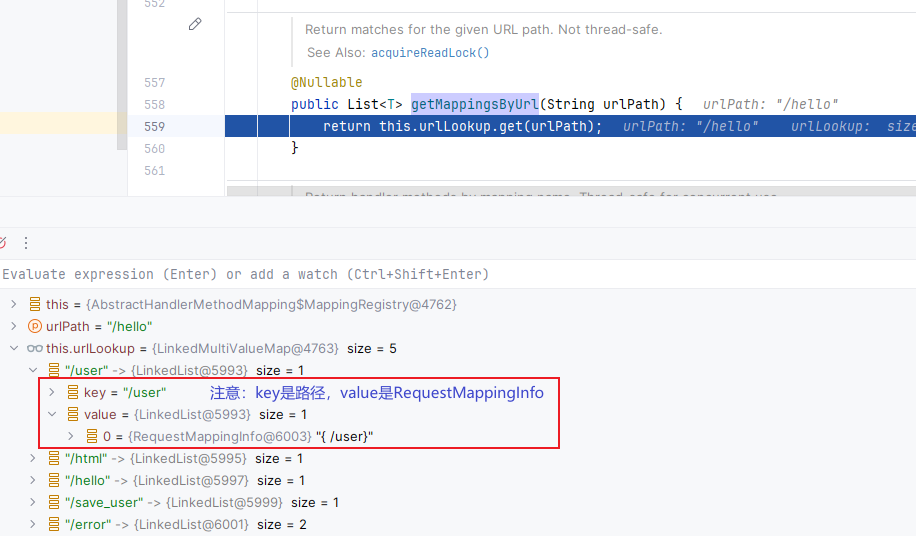
注意:
- PathVariable类型是不会加到这个集合里的,具体逻辑在这里,有兴趣可以去看这两个方法:
org.springframework.web.servlet.handler.AbstractHandlerMethodMapping.MappingRegistry#register()、org.springframework.web.servlet.handler.AbstractHandlerMethodMapping.MappingRegistry#getDirectUrls() - 这里的集合 key 是路径,value 是 RequestMappingInfo
2,得到结果后返回到 lookupHandlerMethod(),继续调用 addMatchingMappings() 方法,来找匹配到的 HandlerMethod:
private void addMatchingMappings(Collection<T> mappings, List<Match> matches, HttpServletRequest request) {
for (T mapping : mappings) {
// 封装一下
T match = getMatchingMapping(mapping, request);
if (match != null) {
// 找到的集合,又会封装为 Match 对象
matches.add(new Match(match, this.mappingRegistry.getMappings().get(mapping)));
}
}
}这里的是:key是 RequestMappingInfo,value是 HandlerMethod:
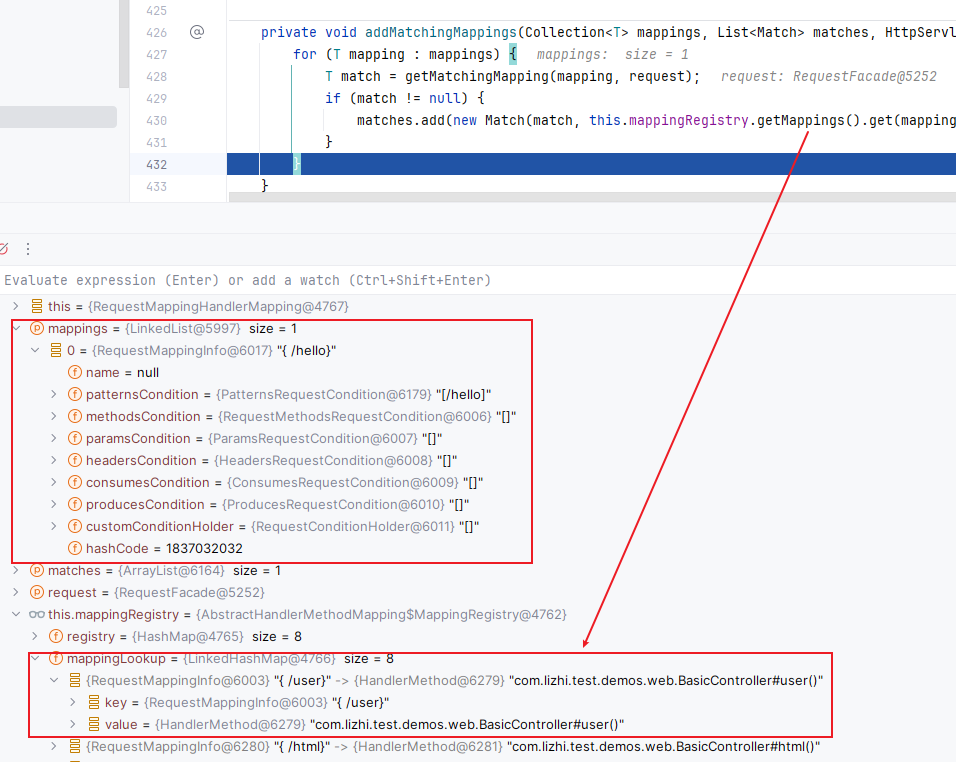
这就是我们找到的 Match 集合:

我们这里就找到了,然后返回到 lookupHandlerMethod() 方法来继续,会先拿到集合中的第一个元素,然后调用 handleMatch() 来处理路径问
题,最后返回Match 对象中的HandlerMethod。到这一步,我们终于拿到了想到的HandlerMethod对象!
HandlerMethod:
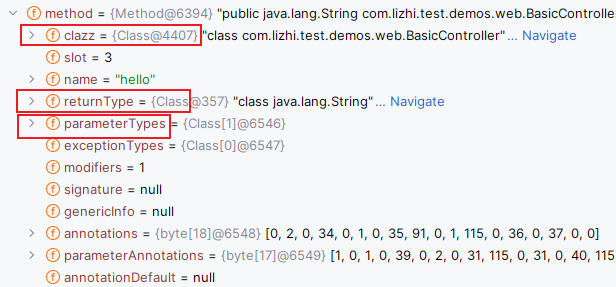
这个对象里面封装了我们的:对应的类、对应的方法、方法的参数类型、方法的返回值类型等等一系列信息
getHandlerExecutionChain()
然后一路返回到 getHandlerInternal() 方法,并调用其中的 getHandlerExecutionChain() 方法来得到 HandlerExecutionChain 对象:
protected HandlerExecutionChain getHandlerExecutionChain(Object handler, HttpServletRequest request) {
HandlerExecutionChain chain = (handler instanceof HandlerExecutionChain ?
(HandlerExecutionChain) handler : new HandlerExecutionChain(handler));
// 拿到路径
String lookupPath = this.urlPathHelper.getLookupPathForRequest(request, LOOKUP_PATH);
for (HandlerInterceptor interceptor : this.adaptedInterceptors) {
if (interceptor instanceof MappedInterceptor) {
MappedInterceptor mappedInterceptor = (MappedInterceptor) interceptor;
if (mappedInterceptor.matches(lookupPath, this.pathMatcher)) {
chain.addInterceptor(mappedInterceptor.getInterceptor());
}
}
else {
chain.addInterceptor(interceptor);
}
}
return chain;
}分析:
1,先把 HandlerMethod 封装到 HandlerExecutionChain 中
2,拿到路径,再遍历所有的拦截器并添加到我们的 HandlerExecutionChain 对象中,然后返回
HandlerExecutionChain:

里面就仨东西:处理器、拦截器集合、当前执行到第几个拦截器的索引
跨域处理
暂无。后续补充
经过这一波操作,我们终于拿到了对应的 HandlerExecutionChain 对象。
getHandlerAdapter()
终于到了我们 HandlerAdapter 了
拿到对应的 HandlerExecutionChain 对象后,我们就该调用 getHandlerAdapter() 方法来拿能处理我们 Handler 的 HandlerAdapter:
protected HandlerAdapter getHandlerAdapter(Object handler) throws ServletException {
if (this.handlerAdapters != null) {
for (HandlerAdapter adapter : this.handlerAdapters) {
if (adapter.supports(handler)) {
return adapter;
}
}
}
throw new ServletException("No adapter for handler [" + handler +
"]: The DispatcherServlet configuration needs to include a HandlerAdapter that supports this handler");
}分析:还是遍历 HandlerAdapter 集合,来调用每一个的 supports() 方法来判断当前是否支持处理这个 Handler。

其实即使判断当前的这个 Handler 是不是某一个类。我们直接来看看
各个类的 supports() 方法:
//*****************AbstractHandlerMethodAdapter 和 RequestMappingHandlerAdapter********************************
public final boolean supports(Object handler) {
return (handler instanceof HandlerMethod && supportsInternal((HandlerMethod) handler));
}
protected boolean supportsInternal(HandlerMethod handlerMethod) {
return true;
}
// *******************HandlerFunctionAdapter*********************************************
public boolean supports(Object handler) {
return handler instanceof HandlerFunction;
}
// *******************HttpRequestHandlerAdapter*********************************************
public boolean supports(Object handler) {
return (handler instanceof HttpRequestHandler);
}
//*******************SimpleControllerHandlerAdapter*********************************************
public boolean supports(Object handler) {
return (handler instanceof Controller);
}我们这里 RequestMappingHandlerAdapter 就能处理,因为我们之前拿到的就是一个 HandlerMethod。
还有一种继承 AbstractController 类来实现的,就是通过 SimpleControllerHandlerAdapter 来处理的,因为 AbstractController 是 Controller 的子类
到此我们就拿到了对应的 HandlerAdapter,这一步还是比较简单的。
mappedHandler.applyPreHandle()
拦截器的前置处理:
boolean applyPreHandle(HttpServletRequest request, HttpServletResponse response) throws Exception {
HandlerInterceptor[] interceptors = getInterceptors();
if (!ObjectUtils.isEmpty(interceptors)) {
for (int i = 0; i < interceptors.length; i++) {
HandlerInterceptor interceptor = interceptors[i];
if (!interceptor.preHandle(request, response, this.handler)) {
triggerAfterCompletion(request, response, null);
return false;
}
this.interceptorIndex = i;
}
}
return true;
}分析:就是拿到我们 HandlerExecutionChain 对象里的 HandlerInterceptor 然后遍历调用其前置处理的方法,每处理成功一个就把当前索引赋值给 interceptorIndex。以便后面拦截器的倒序处理
ha.handle()
这个其实就是用反射来调用我们的方法。invoke()
mappedHandler.applyPostHandle()
拦截器的后置处理
void applyPostHandle(HttpServletRequest request, HttpServletResponse response, @Nullable ModelAndView mv)
throws Exception {
HandlerInterceptor[] interceptors = getInterceptors();
if (!ObjectUtils.isEmpty(interceptors)) {
for (int i = interceptors.length - 1; i >= 0; i--) {
HandlerInterceptor interceptor = interceptors[i];
// 后置处理
interceptor.postHandle(request, response, this.handler, mv);
}
}
}这一次就是倒序处理了。
processDispatchResult()
拦截器的最终处理、还会处理结果 ModelAndView
private void processDispatchResult(HttpServletRequest request, HttpServletResponse response,
@Nullable HandlerExecutionChain mappedHandler, @Nullable ModelAndView mv,
@Nullable Exception exception) throws Exception {
boolean errorView = false;
if (exception != null) {
if (exception instanceof ModelAndViewDefiningException) {
logger.debug("ModelAndViewDefiningException encountered", exception);
mv = ((ModelAndViewDefiningException) exception).getModelAndView();
}
else {
Object handler = (mappedHandler != null ? mappedHandler.getHandler() : null);
mv = processHandlerException(request, response, handler, exception);
errorView = (mv != null);
}
}
// Did the handler return a view to render?
if (mv != null && !mv.wasCleared()) {
// 视图解析器渲染结果
render(mv, request, response);
if (errorView) {
WebUtils.clearErrorRequestAttributes(request);
}
}
else {
if (logger.isTraceEnabled()) {
logger.trace("No view rendering, null ModelAndView returned.");
}
}
if (WebAsyncUtils.getAsyncManager(request).isConcurrentHandlingStarted()) {
// Concurrent handling started during a forward
return;
}
if (mappedHandler != null) {
// 拦截器的最终处理
mappedHandler.triggerAfterCompletion(request, response, null);
}
}由于我们这个是json格式,所以没有 ModelAndView,所以来到拦截器的最终处理:
void triggerAfterCompletion(HttpServletRequest request, HttpServletResponse response, @Nullable Exception ex)
throws Exception {
HandlerInterceptor[] interceptors = getInterceptors();
if (!ObjectUtils.isEmpty(interceptors)) {
for (int i = this.interceptorIndex; i >= 0; i--) {
HandlerInterceptor interceptor = interceptors[i];
try {
interceptor.afterCompletion(request, response, this.handler, ex);
}
catch (Throwable ex2) {
logger.error("HandlerInterceptor.afterCompletion threw exception", ex2);
}
}
}
}这次 i = interceptorIndex,第一次前置处理的时候给这个属性赋的值
到这里 doDispatch() 方法就执行完毕了。
初始化
暂无。
后记
- 跨域的处理
- 返回是 json 格式的时候是怎么处理的?
- 流程图待画
- 初始化的流程
有机会再填坑吧。
